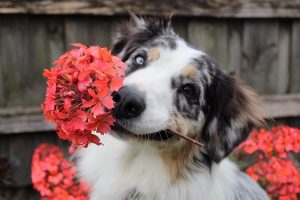 Hunger and curiosity can make for a bad combination. I don’t know about your pet, but most seem to have both traits in spades. The second pets get outside, they often sniff and munch on anything they see from grass to strange plants.
Hunger and curiosity can make for a bad combination. I don’t know about your pet, but most seem to have both traits in spades. The second pets get outside, they often sniff and munch on anything they see from grass to strange plants.
And if your pet can’t eat it, you can bet he’ll roll around in it.
Which begs the question, “Why are pets so interested in all the greenery, and how do we keep them from getting into trouble?”
Well, we’ve got the answers for you today!
Why Do Pets Eat Greens?
Whether you have dogs or cats, you can bet that both will occasionally try to eat plants of some sort, either inside the house and out. It’s pretty natural for them. Dogs, for instance, are omnivores so they’ll often try to squeeze some plants into their diet when they can. Grass also helps dogs with indigestion. Cats, on the other hand, are tried and true meat eaters—they don’t even have the enzymes to digest grass! However, they’ll often eat a little bit every now and then to clean out their digestive tracts and induce vomiting to clear their stomach of indigestible material (think bird feathers and small bones).
This is why you may see Fido and Fluffy vomiting right after eating grass, and yet they carry on with life as usual afterward like it’s no big deal.
But, it can become a big deal if your furry friend eats something poisonous, or more likely, grasses and plants that have been treated with poisonous insecticides or fertilizers.
Tips to Keep Your Pet Safe
Your pet might try to eat grasses and plants every now and then, but here are a few things you can do to keep them safe.
1. Quality food and probiotic supplements. Since pets often eat greens to relieve digestive issues, your pet will feel less need to eat them if their stomach is already happy! Make sure to give them quality food that promotes a healthy gut biome. Pet foods with soluble prebiotic fiber are great. You can usually find them in the treat aisle. Just remember to consult with your veterinarian (you know…us) to determine the right type and amount for your pet. Remember, it’s a supplement, so too much can be a bad thing.
2. Use pet safe products on your own plants. This should be a no-brainer. If you have plants in the house, try to keep them away from your pets. Also, make sure to never use chemicals on your plants (or anywhere in the house) that are harmful to your pet—just in case your cat moonlights as an acrobat and likes to climb around to reach that flowerpot you thought was out of reach.
3. Learn to identify poisonous plants. When you are out and about with your pet, try to keep them from eating grass that isn’t yours and keep an eye out for poisonous flora. If you need a guide, check out this ASPCA site or contact your veterinarian (again, that’s us!) for more info on what’s local to your area.
Hopefully, with these tips in mind, your pet stays safe outdoors. But if your pet does get mixed up in something bad or eats something weird, contact us right away at Peak Performance Veterinary Group and we’ll get you and your animal friend taken care of.
